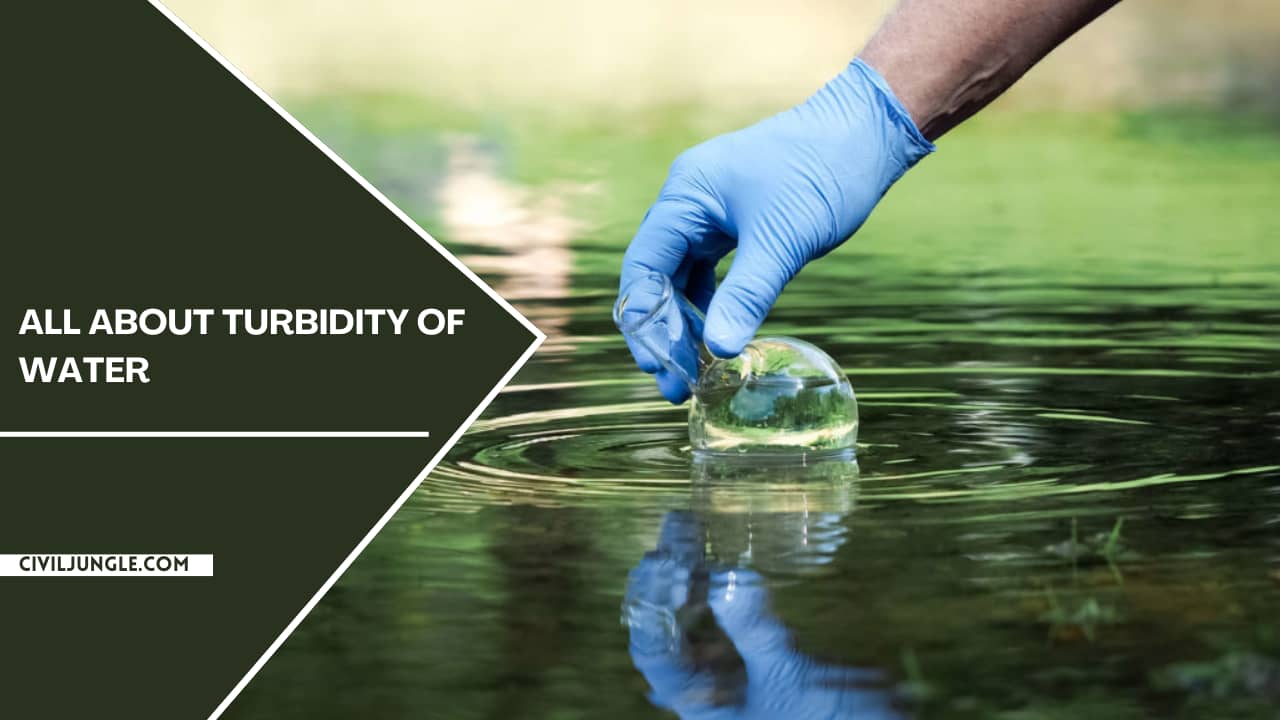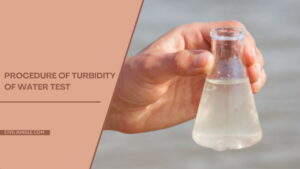
What Is Turbidity of Water?

Turbidity of water is a property of water or liquid by which we can measure the relative clarity of a liquid. The turbidity of water is an optical characteristic of liquid and is a measurement of light reflected through the materials, which are present in the water.
In simple words we can say that turbidity is a determining technique of haziness or cloudiness presence in a water sample. By this technique we can determine the difference between muddy river water vs tap water.
When we examine the waters we can see the muddy water is brown color and presence high turbidity, on the other hand in tap water is colorless and it has very low turbidity.
Turbidity of Water Test
When water contains material of suspense inside it, then it is called turbide water. The turbid is generally made of algae or other organic material, which is measured when the visible materials are suspended in water.
The turbide is a part of clay or silt. The character and amount of turbidity depend on two factors, one is velocity of water and another is the type of soil on which the water flows. The procedure of turbidity of water test is described below –
Apparatus-
For the turbidity of water test many types of apparatus are need that are, nephelo turbidity meter, beakers, glass tubes etc.
Procedure of Turbidity of Water Test

Here, we are going for a water turbidity test. We have divided this test into two parts as follows and let us know in detail.
1. Calibration of Nephelometer
- At first, we have to select the correct range of NTU on the nephelometer.
- After that, we have to fill distilled water on a test tube and set the nephelometer at a zero reading by a knob which is provided for zero setting.
- Next 40 NTU of standard solution is poured in the test tube and set the nephelometer reading at 40 NTU by using a calibration
knob.
2. Determination of Turbidity of Sample Water
- Before analysis it should keep in mind the sample temperature must come at room temperature.
- After this, we have to mix the sample thoroughly to the disperse solid and wait until the bubbles are out of the mixture.
- After removing the bubbles from the mixture we have to pour the water into the test tube.
- If the turbidity is more than 100 NTU, use a cell rise to get the turbidity duration factor.
- After doing the above actions we can see the turbine value on the turbidity meter and note down the value.
Application of Turbidity of Water Test Data
There are have many types of applications of turbidity of water test data, that are below
- The turbidity test is one of the most important tests of water for a water supply because by this test we can know which treatment and how is best for those water.
- By estimating the turbidity of filtered water we can find if there is any fault in the filter.
- By measurement of wastewater turbidity, we can know how the quantity of suspended solid water should be removed from the water.
- From the turbidity information, we can know how more doses and chemicals should me added for filter the supply water.
Frequently Asked Questions (FAQs) about Water Turbidity
What Is Water Turbidity?
Water turbidity refers to the cloudiness or haziness of a liquid caused by large numbers of individual particles that are generally invisible to the naked eye. These particles scatter light, making the water appear less clear.
Why Is Turbidity Important?
Turbidity is a crucial indicator of water quality. High turbidity can affect the health of aquatic ecosystems, indicate the presence of contaminants, and impact the effectiveness of water treatment processes.
How Is Turbidity Measured?
Turbidity is measured using a turbidity meter or nephelometer. The device measures the amount of light scattered by particles in the water sample. The results are typically expressed in Nephelometric Turbidity Units (NTU).
What Is the Procedure for a Turbidity Test?
The turbidity test involves calibrating the nephelometer with standard solutions, preparing the water sample, and measuring the turbidity of the sample. The procedure includes ensuring the sample is at room temperature, mixing it thoroughly, and noting the turbidity reading.
What Equipment Is Used in Turbidity Testing?
Common equipment used for turbidity testing includes nephelometers, beakers, glass tubes, and standard turbidity solutions for calibration.
How Does Turbidity Affect Water Treatment?
High turbidity can indicate the presence of suspended particles or pollutants, which can interfere with disinfection processes and the efficiency of water filters. Accurate turbidity measurements help determine the appropriate treatment methods.
What Are the Applications of Turbidity Data?
Turbidity data is used to assess water quality, detect faults in filtration systems, determine the need for additional chemical treatment, and monitor the effectiveness of water purification processes.
What Factors Influence Water Turbidity?
Factors affecting water turbidity include the velocity of the water, the type of soil or sediment in the area, and the presence of organic material like algae.
How Often Should Turbidity Tests Be Conducted?
The frequency of turbidity testing depends on the water source and treatment processes. Regular monitoring is essential for maintaining water quality and ensuring effective treatment.
Can High Turbidity Be Harmful?
Yes, high turbidity can be harmful as it may indicate the presence of contaminants, impact water clarity, and reduce the effectiveness of disinfection. It can also affect aquatic life by reducing light penetration and clogging fish gills.

